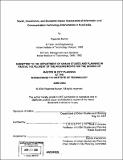| dc.contributor.advisor | Alice H. Amsden. | en_US |
| dc.contributor.author | Kumar, Rajendra, 1967- | en_US |
| dc.contributor.other | Massachusetts Institute of Technology. Dept. of Urban Studies and Planning. | en_US |
| dc.coverage.spatial | n-us-ma | en_US |
| dc.date.accessioned | 2005-06-02T18:17:51Z | |
| dc.date.available | 2005-06-02T18:17:51Z | |
| dc.date.copyright | 2004 | en_US |
| dc.date.issued | 2004 | en_US |
| dc.identifier.uri | http://hdl.handle.net/1721.1/17697 | |
| dc.description | Thesis (M.C.P.)--Massachusetts Institute of Technology, Dept. of Urban Studies and Planning, 2004. | en_US |
| dc.description | Includes bibliographical references (leaves 83-90). | en_US |
| dc.description.abstract | Among the many initiatives in using information and communication technologies (ICTs) for development, telecenters or kiosks occupy a prominent place. These centers provide public access to these technologies and related services through computers and internet. The last decade has seen many such initiatives being launched to bring the benefits of ICTs to the rural population in many countries. As most of these initiatives are relatively recent, there have been few evaluations of their social and economic impacts in their communities. There is also lack of a good understanding about a sound conceptual and theoretical framework for planning and design of such centers. This study seeks to fill a portion of this information gap by focusing on assessing the social, governance, and economic impacts of one such relatively large project in rural India and examining its implications and sustainability within the framework of the theory of diffusion of innovations. The project under study is the widely acclaimed Sustainable Access in Rural India (SARI) project, which has established computer and internet kiosks in over 40 rural communities in Tamil Nadu state in India. The kiosks provide basic computer education, e-mail, web browsing, e-government, health, agricultural and veterinary services. There are four major findings that emerge from this study. First, though the kiosks have succeeded in establishing a visible presence in their communities, their overall reach is still limited. Their users are mostly school and college students, male, and come from a higher socioeconomic status when compared to that of their communities. In this sense, the kiosks may be leading to further exacerbation of the existing socioeconomic inequities within their communities. | en_US |
| dc.description.abstract | (cont.) Second, the kiosks have produced significant governance impacts through increased demand for, and improved delivery of, two e-government services: applications for birth certificates and old age pensions. This seems attributable to the relative advantage of using the kiosk for these services in terms of savings in costs, time, and effort when compared to those in the traditional modes of availing the same services. Third, the kiosks have also produced significant economic impacts through lowering the cost of some services, and creation of new economic and employment opportunities. The services whose costs have been brought down include basic computer education, communication (through email and voice chat), and e-government services. New economic and employment opportunities have been generated by providing computer education to the local youth, and enabling access to online information about jobs. Fourth, the study points out the relevance of the socio-cultural relationships among various castes in the diffusion of kiosks. It points out the importance of location of the kiosks, affordability of the services, relevant and localized content, and adoption and use by local champions within the communities to ensure and sustain their wide diffusion. It also analyzes the potential of providing new services which could be crucial in the financial sustainability of the kiosks. Importance of developing and maintaining new institutional partnerships is also emphasized to ensure relative advantage in the delivery of services ... | en_US |
| dc.description.statementofresponsibility | by Rajendra Kumar. | en_US |
| dc.format.extent | 107 leaves | en_US |
| dc.format.extent | 5384232 bytes | |
| dc.format.extent | 5403250 bytes | |
| dc.format.mimetype | application/pdf | |
| dc.format.mimetype | application/pdf | |
| dc.language.iso | eng | en_US |
| dc.publisher | Massachusetts Institute of Technology | en_US |
| dc.rights | M.I.T. theses are protected by copyright. They may be viewed from this source for any purpose, but reproduction or distribution in any format is prohibited without written permission. See provided URL for inquiries about permission. | en_US |
| dc.rights.uri | http://dspace.mit.edu/handle/1721.1/7582 | |
| dc.subject | Urban Studies and Planning. | en_US |
| dc.title | Social, governance, and economic impact assessment of information and communication technology interventions in rural India | en_US |
| dc.type | Thesis | en_US |
| dc.description.degree | M.C.P. | en_US |
| dc.contributor.department | Massachusetts Institute of Technology. Department of Urban Studies and Planning | |
| dc.identifier.oclc | 56408845 | en_US |
